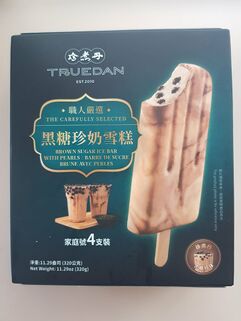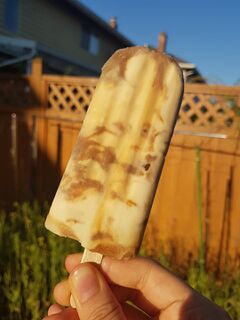Course:FNH200/Projects/2021/Tapioca Pearls
Introduction
Tapioca pearls, most commonly known as boba (a Cantonese slang for “big breasts), or pearls when in bubble tea, is a small and chewy ball of starch. Tapioca starch balls are typically made of starch from the cassava root, and is a mixture of two structurally different polysaccharides. Through recent years, tapioca pearls have been enjoyed in drinks, desserts, candies, and more. [1]
Processing

Cassava root
Cassava root is typically the main ingredient found in pearls, it's what makes your favourite topping at the bottom of your drink. This root appears like an oddly shaped carrot and is mainly used for its starchy properties. A starch known as tapioca is extracted from the root to produce what we know as tapioca pearls.[2] This process unique to starches is known as “gelatinization”, where the tapioca starch and water come in contact and are subjected to heat, causing the starch to swell. The temperature of gelatinization is unique to each source of starch, tapioca starch has a gelatinization temperature of 59°C-65°C. As the mixture reaches its optimal temperature the starch granules absorb around five times their own volume of water. Eventually, the granules begin to burst and release a polysaccharide called amylose. The granules burst as a result the hydrogen bonds form between the water and starch molecules (refer to module 2.2.1.1 on canvas). Amylose causes the liquid to thicken creating the “syrupy” sauce that covers the pearls. [3] The result of the gel gives the pearls the bouncy and sticky consistency. [4]
Sodium Carboxymethyl
Sodium Carboxymethyl is a common ingredient in most pearls to thicken the syrup, it’s a type of cellulose that is water soluble in any temperature. It’s commonly added because it increases the viscosity of the liquid released by the pearls.[5] Cellulose are polymers made of glucose which falls under the category of an “indigestible carbohydrate” referring to the FNH200 Module 2.2.1.1 . In Canada, it’s considered a permitted food additive listed on the website of the Government of Canada. Xanthan gum, a polysaccharide, is added to several brands of pearls as well, as it acts as a thickener like sodium carboxymethyl. [6]
Brown sugar
Brown sugar is added to the liquid to sweeten the syrup made by the starch as well as to caramelize the product. High temperatures are needed to produce the caramel flavours and to create the brown colour of the pearls. [7] The Maillard reaction also occurs between the invert sugar monosaccharides in brown sugar and the nitrogen parts of amino acids in the pearls which contributes further pigment to the pearls and flavour.
Preservatives
From brand to brand the specific formulation can be different depending on the variety (vacuum sealed, frozen, or ready to eat). Most vacuum sealed pearls contain Potassium Sorbate and Sodium Benzoate as preservatives. Preservatives are added to tapioca pearls primarily to inhibit the growth of microorganisms. Since tapioca pearls ,before cooking and therefore gelatinization, are mainly dehydrated starches that degrade slowly; there is not a need to add chemical preservatives in order to keep the flavours, texture, structure, and aromas. Often tapioca pearls are dehydrated and come in a vacuum sealed package which prevents the growth of microorganisms due to the low water content and activity of the product. But once the pearls are taken out of their packaging they become extremely susceptible to soaking up free water from the environment around them.
Potassium Sorbate
Potassium Sorbate stops the growth of mold, yeast, and fungi on the pearls. The exact mechanism by which it works by is not fully understood yet but research suggest that it inhibits the growth of spores during the initiation phase by disturbing the electron and proton transport.[8]
Sodium Benzoate
Sodium Benzoate is the salt of Benzoic acid[9]. In the microorganism cell it converts to benzoic acid which causes the pH to acidify to 5 or lower, phosphofructokinase, an essential enzyme involved in the production of ATP is unable to function in these conditions. Since ATP is essential for the cell to survive, if it is unable to produce ATP it will die.
Packaging

Tapioca pearls are mostly packaged in vacuum sealed plastic packaging. The goal of vacuum packaging is to prevent food spoilage and deterioration by aerobic microorganisms, particularly mold. Tapioca starch, which is the food’s main ingredient, is prone to mold when exposed to high humidity air or moisture. Research has shown that water activity significantly affects the microbial load of tapioca starch and cassava flours. When water activity was lowered, microbial count was also found to be reduced[10]. Vacuum packaging also prevents tapioca pearls from turning “sweaty” before cooking since it acts as a barrier between the pearls and the humidity in the air. When vacuum packed, the tapioca pearls are unable to adsorb moisture from the air. Multiple tapioca pearl recipes and blogs have also advised to cook and consume tapioca pearls at most a day after opening the vacuum seal. [11][12]
This can also be the reason why tapioca pearls are often sold as dehydrated pearls, which upon boiling turns into the chewy pearls we have come to love. Referring to FNH200’s Module 5.6 on Canvas, dehydrating food products lowers its water activity and free water. This in turn takes away the microbial cell’s source of water and prevents it from multiplying or using it for “chemical, microbial and enzymatic reactions”
Problems of the Cassava Root
Cassava Root and Cyanide
The cassava root, that is used to make tapioca starch, contains naturally occurring cyanide. The cyanide occurs in tapioca in the form of cyanide glycosides, also known as linamarin, which constitutes 93 percent, and lotaustralin, which constitutes 7 percent of the cyanide. Once the starch has been correctly prepared, cyanide within the starch will disappear. As cyanide is toxic to most organisms, with the human body's central nervous system being particularly sensitive, if incorrectly prepared, and cyanide remains within the tapioca, humans may show the following symptoms of chronic cyanide poisoning: headache, vertigo, nausea, vomiting and tremors.
Environmental Impact of the Cassava Root
While the cyanide within the tapioca will be gone once the cassava root has been prepared, the wastewater that is also produced will still contain cyanide. In many developing nations such as Thailand, and much of Southeast Asia, it has been found that wastewater leaking has caused problems with marine life, other animals that survive on marine life. Marine life is extremely vulnerable to cyanide, as massive fish kills have been found in even extremely low concentrations of less than 0.3 mg L⁻¹. Also, a common practice of local and traditional tapioca processing in Southeast Asia, people use the untreated wastewater for irrigation of farmland, which has been found to be harmful on crops like rice and vegetables.[13]
Varieties
“Black” boba vs Clear boba vs Flavoured boba
- Black: black coloured tapioca pearls are the most common, and are often considered the “standard” bubble tea pearls. Brown sugar or caramel colouring is added to the ingredients to give the tapioca pearl extra sweetness. The boba will typically be chewy and bouncy.

Brown sugar bubble tea ice cream bar box - Clear: Clear boba is the same as black boba, with the only difference being that there is no brown sugar or caramel colouring added, with only the cassava root being used as the starch. It is not sweet, but can absorb flavours of the drink around it. For example, if placed into milk tea, the clear boba will absorb the flavour of the milk tea.
- Flavoured boba: Sometimes, boba will be cooked or coated with flavoured syrups rather than the original brown sugar or caramel colouring.
Food products
- Bubble tea drinks have been popular in Asia for many years. In recent years, the popularity of tapioca pearls in both drinks and foods have exploded among popular culture in Western society. Many companies have made changes and come up with new varieties of foods that have become available in Canada, and across the globe, such as bubble tea flavoured ice cream, with tapioca pearls, and bubble tea flavoured candy

Brown sugar bubble tea ice cream bar
Potential Exam Question
Q: "Why are tapioca pearls often sold as dehydrated products?
A:To protect the product from soaking up moisture from its environment and causing food spoilage, microbial growth, and enzymatic reactions. Starches are prone to microbial growth so the introduction of free water would allow for undesirable microorganisms such as bacteria, mold, and fungus to grow which would make the tapioca pearls unsafe for consumption.
Why Our Question Should be Picked: This question should be used on the final exam because it covers one of the most important lessons in FNH 200: water activity and methods of preservation. The answer to the question is definitely within the scope of the class but also requires the student to think on their own in order to identify the correct answer.
Sources
Initial Sources
- Preservatives & Additives: https://www.jstage.jst.go.jp/article/jhej1987/41/2/41_2_123/_article/-char/ja/
- Processing of Cassava Flour: https://www.cdc.gov/mmwr/volumes/68/wr/mm6813a3.htm
- Chemistry Behind Pearls: https://itsamaterialsworld.wordpress.com/2018/12/26/breaking-boba-the-chemistry-of-bubble-tea-pt-1/
- Varieties of Pearls: https://www.happyteahousecafe.com/blog/2016/08/a-look-at-the-different-types-of-boba/
- Most Common Types of Boba: https://spoonuniversity.com/lifestyle/5-most-common-types-of-boba-explained
- How Pearls are Made: https://www.jstage.jst.go.jp/article/jhej1987/40/5/40_5_363/_article/-char/ja/
- Preparation of the Orange Flavoured Boba: https://res.mdpi.com/applsci/applsci-11-00200/article_deploy/applsci-11-00200.pdf
- Vacuum Packaging: https://nchfp.uga.edu/publications/uga/vacuum_packaging.html
- ↑ Krishna, Priya (June 6th 2017). "A Brief History of Boba". Food & Wine. Retrieved August 1st, 2021. Check date values in:
|access-date=, |date=(help) - ↑ Shigaki, T. "Cassava: The Nature and Uses".
- ↑ "gelatinization". Opentextbc.
- ↑ "CARBOHYDRATES: GELATINISATION".
- ↑ Ergun, Guo, Huebner-Keese, R, J, B (2016). "Cellulose". ScienceDirect.CS1 maint: multiple names: authors list (link)
- ↑ "List of Permitted Food Additives with Other Accepted Uses". Government of Canada.
- ↑ Krystyjana, Sikora,Adamczyka, Tomasik, Magdalena, Marek, Greta, Piotr (5 April 2012). "Caramel sauces thickened with combinations of potato starch and xanthan gum". ScienceDirect.CS1 maint: multiple names: authors list (link)
- ↑ Sofos, J.N. "Mode of action of sorbic acid on bacterial cells and spores".
- ↑ Krebs, H.A. "Studies on the mechanism of the antifungal action of benzoate".
- ↑ Elohor Oghenechavwuko Udoro, Tonna Ashim Anyasi, Afam Israel Obiefuna Jideani. (2020) Characterization of the root and flour of South African Manihot esculenta Crantz landraces and their potential end-use properties. International Journal of Food Properties 23:1, pages 820-838.
- ↑ "How to Store and Keep Tapioca Pearls". Bossen Store. June 15 2017. Check date values in:
|date=(help) - ↑ "Boba FAQ". Bubble Tea Supply.
- ↑ Bengt-Erik, Bengtsson; Triet, Tran (December 1994). "Tapioca-Starch Wastewater Toxicity Characterized by Microtox and Duckweed Tests". Retrieved August 1st 2021. Check date values in:
|access-date=(help)

